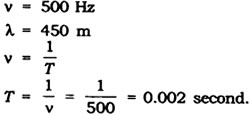Question: How are the wavelength and frequency of a sound wave related to its speed?
Answer: Speed of sound Frequency X Wavelength
Question: A person is listening to a tone of 500 Hz sitting at a distance of 450 m from the source Of the sound. What is the time interval between successive compression from the source?
Answer:
Question: Distinguish between loudness and intensity of sound.
Answer: The loudness depends on energy per unit area of the wave and on the response of the ear but intensity depends only on the energy per unit area of the wave and is independent of the response of the ear.
Question: In which of the three media, air, water or iron, does sound travel the fastest at a particular temperature?
Answer: Sound travels fastest in iron as compared to water and air.
An echo is returned in 3 s. mat is the distance of the reflecting surface from the source, given the speed of sound is 342 m s-1
Question: Why are the ceilings of concert halls curved?
Answer: The ceilings of concert halls are curved because sound after reflection from it reaches all the corners of the hall and is audible to each person in the hall.
Question: What is the audible range of the average human ear?
Answer: An average human ear can hear sound waves between frequencies 20 Hz to 20,000 Hz.
Question: What is the range of frequencies associated with (1) Infra sound? (2) Ultrasound?
Answer:
- Infra sound: Sound waves between the Frequencies 1 and 20 Hz.
- Ultrasound: Sound waves of the frequencies above 20,000 Hz.
Question: What is sound and how is it produced?
Answer: Sound is mechanical energy which produces a sensation of hearing. When an Object is set into vibrations, sound is produced.
Question: What is the speed of sound?
Answer:
- In air → 344 m/s
- In water → 1500 m/s
- In iron → 5130 m/s
Question: A jet craft files at a speed of 410 m/s. What is this speed known as?
Answer: Supersonic speed.
Question:Which term is used to denote a speed greater than the speed of sound ?
Answer: ‘Supersonic’
Question:What will be the change in the wavelength of a sound wave in air if its frequency is doubled ?
Answer:
Now,
V = λ × f
f = V/λ
2 f = 2v/λ
So, wavelength (λ) is halved.
Question: If 20 waves are produced per second, what is the frequency in Hertz ?
Answer: 20 Hz.
Question: A cricket ball is seen to hit the bat first and the sound of hitting is heard a little later. Why?
Answer: This is because light travels faster than the light reflected from bale reaches us faster than the sound of hitting. So, a Cricket ball is seen to hit a bat first and the second of hitting is heard a little later.
Question: Explain why, the flash of a gun shot reaches us before the sound of the gun shot.
Answer: This is because the light from flash reaches us faster than sound as light travels faster than sound.
Question: Give reason for the following :In most of the cases, we cannot see the vibrations of a sound producing object with our eyes.
Answer: This is because in most of the cases, a sound producing object vibrates so fast that we cannot see its vibrations with our eyes.
Question: (1) When we put our ear to a railway line, we can hear the sound of an approaching train even when the train is far off but its sound cannot be heard through the air. Why ?
(2) How could you convince a small child that when you speak, it is not necessary for air to travel from your mouth to the ear of a listener ?
Answer:
- This is because the speed of sound is highest in solids. The sound of approaching train can be heard by putting ear to railway line made of steel because sound is quickly carried in comparison to that in air which is a gas.
- When we speak the sound makes the air molecules, nearby vibrate. These vibrating air molecules make the next layer of air molecules to vibrate and so on. So, sound is an energy which is passed by air molecules. Air molecules do not travel in this process. So, it is not necessary for air to travel from our mouth to the listener’s ear.
Question: Cite an experiment to show that sound needs a material medium for its propagation.
Answer: Take an electric circuit which consists of a cell, a switch and an electric bell arranged inside a bell jar, which stands on the platform of an evacuating pump. The switch of the bell is pressed to close the electric circuit. When there is air within the bell jar, sound is heard. Air is now pumped out of the bell jar. When the air is completely removed from the bell jar, no sound is heard as it is obvious from fig. because the medium of air which has to carry energy from the bell to the bell jar is removed. It shows that sound needs material medium for its propagation.
Question: Why is sound wave called a longitudinal wave?
Answer:Sound wave is called longitudinal wave because the particles of the medium vibrate in the direction of the propagation of wave.
Question: Which characteristic of the sound helps you to identify your friend by his voice while sitting with others in a darkroom?
Answer: The characteristic of sound is quality or timbre.
 Class Notes NCERT Solutions for CBSE Students
Class Notes NCERT Solutions for CBSE Students




